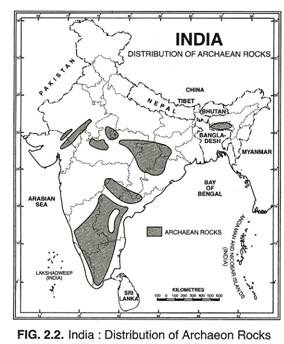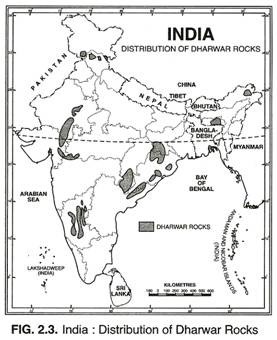Here is your paragraph on the Archaean rock system of India!
The word ‘Archaean’ was first used by J.D. Dana for rock structure prior to the Cambrian system. Obviously the Archaean rocks are the oldest in the world.
The Archaean rock system includes the following rock groups:
(a) The Archaean System-Gneisses and Schists:
These are the oldest rocks and were the first to be formed at the time of cooling and solidification of the upper crust of the earth’s surface in the pre- Cambrian era (about 4000 million years ago). Although their broad characteristics are well known, the details of their origin continue to arise considerable speculation.
ADVERTISEMENTS:
They are all azoic, thoroughly crystalline, extremely contorted and faulted, often formed as plutonic intrusions and generally have a well defined foliated structure. They often underlie strata formed subsequently and the system is generally known by names of the ‘Fundamental Complex’ or the Basement Complex. Their details are complex but recent advances in geochemistry are likely to enhance our understanding of their formation.
The most common Archaean rock covering about two-thirds of the peninsular surface is the gneiss. This is the rock which in mineral composition may vary from granite to gabro, possesses a constant, more or less foliated or banded structure. The schists, mostly crystalline, include mica, talc, hornblende, chlorite, epidote sillimanite and graphite schists.
ADVERTISEMENTS:
The crystalline metamorphosed sediments and gneissic rocks cover large parts of India. The central and the southern parts of the Peninsula are occupied by this rock system. To the north-east of the Peninsula, they occupy wide areas in Orissa, Meghalaya, Madhya Pradesh, Chhattisgarh and Chotanagpur plateau of Jharkhand.
They also cover the whole of Bundelkhand in the north and to the north-west, they are found in a number of isolated outcrops, extending from north of Vadodara to a long distance along the Aravalis. In the extra-peninsula, these rocks are exposed all along the Himalayas, forming the bulk of the high ranges and the backbone of the mountain system (Fig. 2.2).
(b) The Dharwar System:
This system derives its name from the rocks first studied in the Dharwar district of Karnataka where such rocks are found in abundance. The Dharwars include some of the highly metamorphosed rocks of both sedimentary and igneous origin.
According to Wadia, the Dharwar System is the most ancient metamorphosed sedimentary rock-system of India, as old as, and in some cases older than, the basement gneisses and schists. He further adds that the weathering of the pristine Archaean gneisses and schists yielded the earliest sediments which were deposited on the bed of the sea, and formed the oldest sedimentary strata, known in the geology of India as the Dharwar system.
Some of the metamorphosed rocks of the igneous origin are also included in this system. Most rocks of the Dharwar system are so metamorphosed that they are practically indistinguishable from their primitive formations.
ADVERTISEMENTS:
The major rocks of the Dharwar system are hornblende, schists, quartzites, phyllites, slates, crystalline limestones and dolomites. These rocks were deposited in three major cycles, the earliest one is over 3,100 million years old and the latest one about 2,300 million years. They were metamorphosed around 1,000 million years ago.
The Dharwar system is very well developed in the Dharwar-Bellary-Mysore belt of Karnataka. It also occurs in Jharkhand (Ranchi, Hazaribagh), Madhya Pradesh (Balaghat, Rewa), Chhatisgarh (Bastar, Dantewara, and Ranker), Orissa (Sundergarh, Keonjhar) and in the Aravalis between Jaipur and Palanpur. In the extra-Peninsular region, the Dharwar system is well represented in the Himalayas both in the central and northern zones as well as in the Meghalaya plateau (Fig. 2.3).
The Dharwars are economically the most important rocks because they possess valuable minerals like high grade iron-ore, manganese, copper, lead, gold, quartzites, slates, mica, etc.

